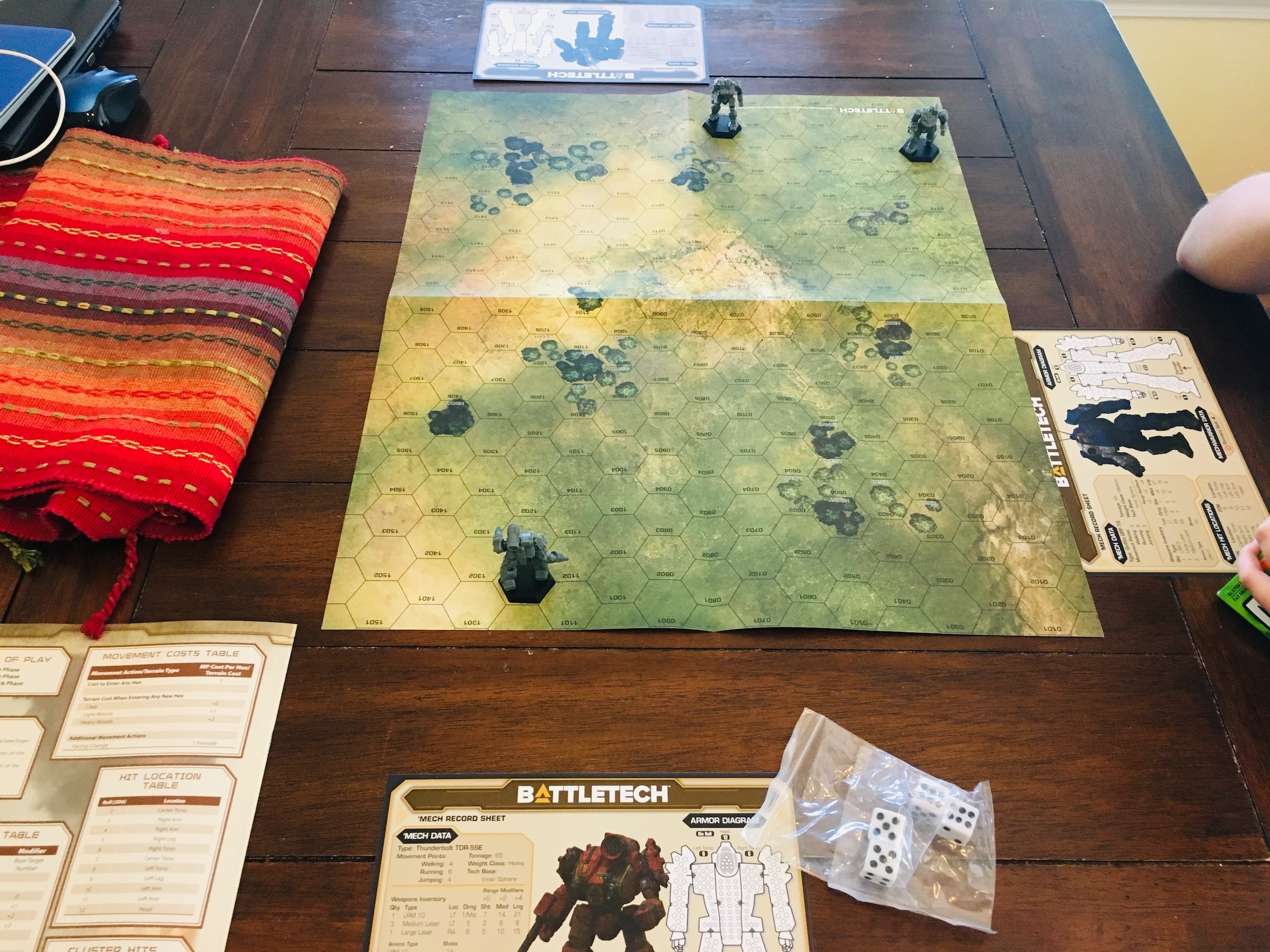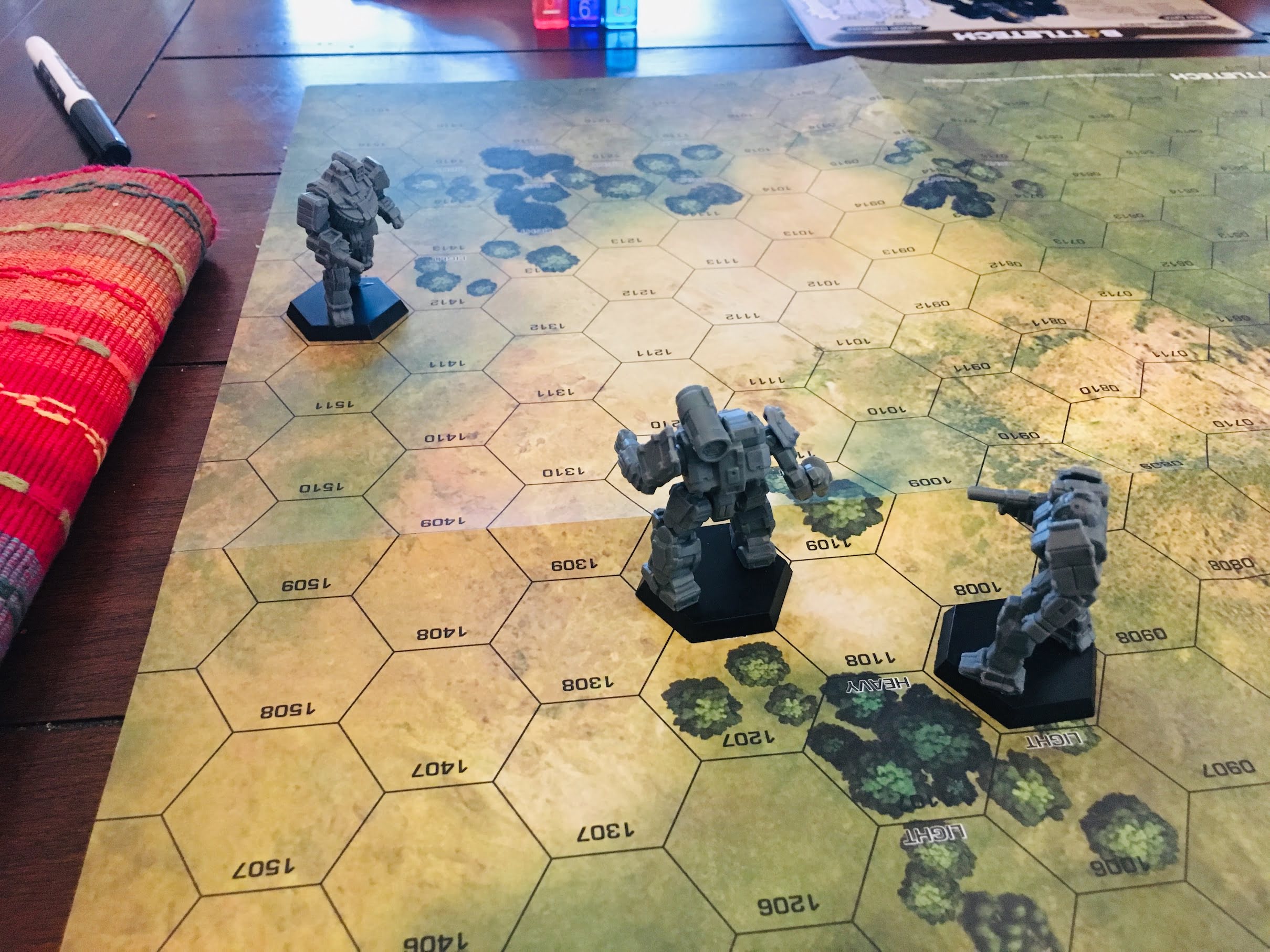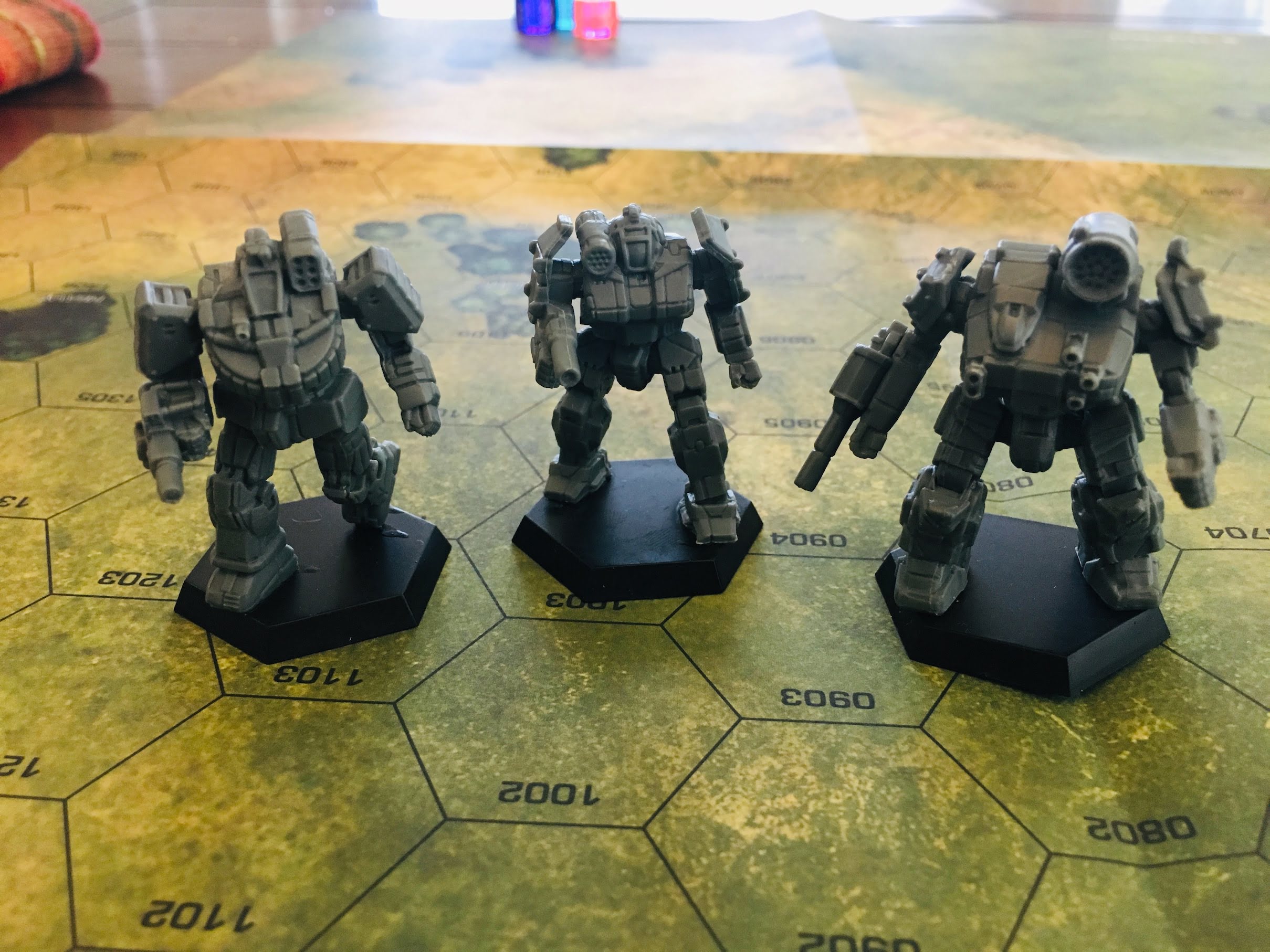What Is BattleTech?
BattleTech is a tabletop wargame that puts players in the cockpit of giant mechanical robots (called BattleMechs). These MechWarriors duke it out by maneuvering in and around terrain such as trees, lakes, and more… and firing deadly weapons such as lasers and missiles. Dice are rolled to determine whether weapons hit as well as the location and amount of the damage. Plastic miniatures are provided that have matching special data sheets that can be written on with dry-erase markers to track damage and ammo usage. Scenarios are included, but one-off games are also supported.
Note: This review will cover the BattleTech Beginner Box that introduces the basic rules of the game. More advanced rules are covered in the BattleTech: A Game of Armored Combat game box.
BattleTech Beginner Box Components
Included in the BattleTech Beginner Box are the following components:
- Quick Start Rules — 12-page booklet that gets you up and playing fast
- Two BattleMech Miniatures — Griffin and Wolverine models
- Punchboard BattleMechs — additional cardboard printed tokens and stands to represent more ‘Mechs
- ‘Mech Record Sheets — provide info on armor, weapons, etc., and are laminated for use with dry-erase markers
- MechWarrior Cards — special pilot cards that provide special abilities
- Terrain Mapsheet — hex-grid, double-sided map with terrain printed on it
- Dice — 2x six-sided dice provided (also called 2d6)
- Instant Guide to the Inner Sphere — overview of the BattleTech universe and history
- Golden Rule — small short story booklet set in the BattleTech universe
Not included but recommended:
- 3x six-sided dice per player — (3 different colors – black, red, white recommended) — these are used to track the type of movement your ‘Mech makes — walk, run, jump. Additionally, the three dice are used to track values related to combat (this will be explained below).
How to Play BattleTech
Objective
Players attempt to satisfy the victory conditions of unique scenarios provided in expansions for the game. The Beginner Box comes with a single scenario; the victor is the one with the last surviving ‘Mech on the battlefield.
Setup
For the Beginner Box game, players choose to use either the desert or grasslands map. One player places their ‘Mech figure within 3 hexes from the south side edge of the map. The other player places their ‘Mech within 3 hexes of the north side edge of the map. One player will use the GRF-1N Griffin ‘Mech… the other the WVR-6R Wolverine ‘Mech, choosing the matching ‘Mech Record Sheet.
Your Turn
During a turn, players will move and fire weapons. Each turn is divided into three phases:
- Initiative Phase — Each player rolls 2d6. The highest roll wins Initiative for that turn. Ties are re-rolled.
- Movement Phase — The loser of Initiative moves first. (This provides the winner with a slight edge since he will see where the opponent moves.) Players can choose not to move.
- Weapon Attack Phase — The loser of Initiative declares attacks and target(s). Players can choose not to fire weapons. During this phase, weapons are fired, hits/misses are determined, and any damage is assessed.
After the Weapon Attack Phase for the Initiative winner ends, a new turn begins and players roll for Initiative again.
The Movement Phase
Movement in BattleTech is fast to learn. ‘Mechs have four options: Stand Still, Walk, Run, or Jump. (Note: Not all Mechs can Jump.) Each ‘Mech’s Record Sheet indicates a MP (Movement Points) value for Walk, Run, and Jump. That value represents the maximum distance (in hexes) that the Mech may choose to move when selecting that Movement Type. (Unused MP points are lost at the end of the Movement Phase.)
The Wolverine WVR-6R, for example, has Walking 5, Running 8, and Jumping 5. This means it can walk up to 5 hexes, run up to 8, and jump up to 5. Each movement type comes with penalties applied to both attacker and defender during combat that will be explained later.
A ‘Mech always faces one hex side (giving a total of six possible facings), and this determine firing arcs for weapons as well as forward and backward movement. A ‘Mech may only move forward into a hex it is facing… or backwards to the hex directly behind it. A ‘Mech may change the direction it is facing at a cost of 1MP per change of hex side. A 180-degree rotation will cost 3MP.
‘Mechs may not walk, run, or jump through a hex occupied by another ‘Mech, although they may jump over an occupied hex if they have Jumping MP points and change facing at no cost.
Terrain can effect movement. Light woods cost +1 MP to move into and Heavy woods cost +2MP. This is in addition to the 1MP cost to move per hex. For example, if the Wolverine with Jumping 8 wants to Jump 3 hexes away from its current position into Heavy Woods, that will cost 5MP (3 for the distance, +2 for Heavy Woods).
The Weapon Attack Phase
Before describing combat, players will need to determine if Line-of-Sight (LOS) is present for an attack and declare their attacks. LOS is determined by plotting a line from the center of both ‘Mech figures. Each hex the line passes through, no matter how small an amount, counts as a hex of distance. In addition, if any LOS passes through 3 points or more of terrain, there is no line of sight. These points are 1 for Light woods and 2 for Heavy woods, and any woods the Target or Attacker is standing in does not count towards this total. If LOS exists, a player may declare an attack on a target.
NOTE: Intervening ‘Mechs between Attacker and Target do not count towards the 3 points used to calculate LOS.
Combat in BattleTech is made easier by using an acronym: GATOR. Each letter reminds players how to calculate the Target Number (TN). The TN is the value the player must equal or exceed by rolling 2d6 and totaling the dice values. The higher the TN, the more difficult it will be to hit the target. Anything over 12 is considered impossible.
Gunnery Skill Raring: By default, it is 4 if using the generic ‘Mech Record Sheets, but can be improved if players use the optional MechWarrior Cards. This value is added to the remaining acronym values below.
Attacker Movement Modifier: The Attacker ‘Mech’s choice of movement (Stand Still, Walk, Run, Jump) may increase the value of the TN. Walking is +1, Running is +2, and Jumping is +3.
Target Movement Modifier: Just as the Attacker’s choice of movement affects the final TN value, so does the movement of the Target. Instead of the type of movement, however, this modifier is based on total number of hexes moved from its initial position. A Target that moves 7-9 hexes in total after leaving its original position (not necessarily distance) has a +3 TN. Jumping Targets add an additional +1 TN.
Other Modifier: For the Beginner Box, this only covers terrain. (For the advanced game found in BattleTech: A Game of Armored Combat, there are other modifiers). If LOS passes through woods, +1 TN per light wood hex, +2 per heavy wood hex. If the Target is standing in light wood or heavy wood, this adds a bonus +1 or +2 TN respectively.
Range Modifier: Each weapon a ‘Mech possesses has a range beyond which it cannot fire. This distance (in hexes) is broken into Short, Medium, and Long range. Short range modifier is 0, Medium range is +2 TN and Long range is +4. For example, the Wolverine’s Medium Laser has values of Short 3, Medium 6, and Long 9. This means the Wolverine may fire the lasers between 0-3 hexes at no penalty, 4-6 hexes at +2, and 7-9 hexes at +4 TN. At 10+ hexes, the target will be out of range for the Medium Laser.
When a player declares an attack with a weapon against a target, he simply uses GATOR to make the TN calculation. So, the Wolverine that ran wishes to fire its Medium Laser on a target 4 clear hexes away but standing in heavy woods. The target entered the heavy woods after moving 4 hexes. The calculation is made as follows:
G (4) + A (+2) + T (+1) + O (+2) + R (+2) = 11
That’s going to be a hard shot to make rolling 2d6. Only an 11 or 12 will hit. The Wolverine rolls an 11! This means attack location and damage amount needs to be determined.
Hit Location and Damage
When a weapon attack is successful, the location and damage must be determined. The Attacker rolls 2d6 and consults the Hit Location Table. A roll of 7, for example, is on the Center Torso. A roll of 12 is the Head. Possible locations include Head, Left and Right arms, Left and Right legs, Left and Right Torso, Center Torso — a total of 8 locations.
Once the location is determined, the weapon’s damage is applied. This information is found on the ‘Mech’s Record Sheet in the DMG column for each weapon type. A value of 6 means the Defender will mark 6 pips of armor off from the attack’s location. (Each ‘Mech Record Sheet has a schematic of the mech with small circles representing points of armor. As points of damage are applied, players darken a circle with a dry-erase marker.)
For missiles, the size of the weapon is consulted; missile weapons come in 2, 5, 6, 10, and 15 varieties, and another 2d6 is rolled to determine how many of the missiles actually hit the target. For a SRM/6 (Short Range Missile, 6 missiles per shot, 15 shots in all), a roll of 2d6 and a value of 8 means that 4 of the 6 missiles hit. Each missile weapon has a DMG that is PER MISSILE, so a value of 2/Msl would mean that the above attack did 8 points of damage (4 missiles of 6 x 2 points per missile).
Damage is tracked using the ‘Mech Record Sheet. Each ‘Mech location (such as Left Arm or Right Torso) has a limited amount of armor. When that armor is gone, any leftover damage is applied to another body part indicated by a small arrow. For example, the Left Arm has an arrow pointing to the Left Torso. When the Left Arm’s armor is gone and 2 points of damage remain to be applied, this damage moves to the Left Torso. When the Right or Left Torso is completely damaged, additional damage moves inward towards the Center Torso PLUS the Left or Right Arm is also detached and incapable of firing any weapon that it holds or is mounted there!
When either the Center Torso or Head have lost all armor, that ‘Mech is destroyed no matter how much armor is left on the Legs, Arms, or Left/Right Torso.
Winning
Most scenarios have the winner as the last ‘Mech standing, but one advanced scenario (in the BattleTech: A Game of Armored Combat) has a victory conditions based on getting a special ‘Mech attacker of the map on the opposite side of three enemy defenders.
Why You Should Play BattleTech
I played BattleTech in high school; yeah, the game has been around for a while… and in various formats such as video game, roleplaying game, and more. (There was a fully-immersive arcade style game of BattleTech that put players in pods that shook and had alarms and controls!) It was such a great game, but it lacked the plastic ‘Mech figures — we had to make our own or use cardboard cutouts. The rules were also a little more complicated (IMO) and not so much fun for novices to jump into. But even then, it was still a blast to imagine yourself running and jumping around in these mega killer robots… so I’m excited to see the game in this new (and, I believe, improved!) version.
The BattleTech Beginner Box comes with everything you need to play for 2 or more players. With 2 players, you can use the two included plastic ‘Mech minis, but for more than 2 you’ll need to use the cardboard punchouts unless you buy the BattleTech: A Game of Armored Combat expansion that brings 8 additional plastic minis plus advanced rules (more on that shortly).
With the GATOR acronym, players will quickly figure out the combat part of the game. I played the game with my two boys (ages 11 and 8) and after only a couple rounds, they were both calculating their own TNs for attacks against Dad. I let them team up against me and they whooped me good once they figured out some basic tactics of working together to reach my blind spots. My 11 year old was screaming for another game and begging for me to invite some of his friends over to teach them. And we’re going to do exactly that — a BattleTech game at my house is scheduled in a few weeks with five of his friends.
The game is fast, easy to learn, and will bring lots of grins and shouts of joy (and despair) when crazy shots work, arms are blown off, and ‘Mechs tumble to the ground in defeat.
Should you decide you want to up your BattleTech game a bit, you’ll want to consider purchasing the BattleTech: A Game of Armored Combat expansion that provides additional features such as:
- more types of terrain that include water, rubble, pavement and more
- more advanced Mech Record Sheet
- potential damage applied to the MechWarrior driving the ‘Mech
- rules related to heat buildup as the ‘Mech moves and fires weapons
- three new turn phases — Physical Attack phase, Heat Phase, End Phase
- terrain level features — rules for firing above and below
- firing arc rules that make combat more interesting
- combat and movement in water!
- more advanced hit location table
- physical attack rules for kicking, punching, shoving, and more
- critical hit rules!
- rules related to Piloting Skill for more advanced combat techniques
- three scenarios
- construction rules — build your own ‘Mech!
All in all, I’m quite taken with BattleTech, and I plan on playing it more with my boys. I’ve finally found a game that both boys really enjoy playing with me (they still prefer their videogames, but if they’ll play a game of BattleTech with me once or twice a week, I’ll take it!) and while I think we’ll stick with the Beginner Box rules for now, I imagine it won’t be long before my 11 year old wants to start using the advanced rules. I’m game!
Note: The ‘Mech minis come unpainted… but the back of the advanced rule book found in BattleTech: A Game of Armored Combat expansion box has some beautiful examples of painted mechs from four different painters that provide some nice inspiration.
The BattleTech Beginner Box and The BattleTech: A Game of Armored Combat box will both be available on Jan 23, 2019.
Disclosure: James was provided review copies of both BattleTech Beginner Box and BattleTech: A Game of Armored Combat.











Awesome!
It’s great to see at least a couple plastic BattleMechs included with the set. In my best grandpa Simpson voice – “Back in my day the game only came with punchboard BattleMechs with plastic bases.”
Now to find players and, more importantly, Time to play.
Chris, If you’re interested in playing, I might be able to convince my son and some of his friends to join you and me in a skirmish. Let me know.
Jim
Consider using the open source app MegaMek (and MekHQ) on your computer in between matches to reinforce your BattleTech knowledge. (disclaimer: I’m one of the developers)
Nice review! I am waiting in suspense for my own to arrive!
My only critique, if I may be so bold, is that the description of jump movement is slightly off. The Wolverine in the example would have only spent 3 jumping MP to enter the hex described.
“A jumping ‘Mech can move 1 hex for each available Jumping MP. Terrain does not affect this MP cost: if a hex is legal to enter, it costs 1 MP to move over or into it, period,” (BATTLETECH: BattleMech Manual, p. 18).
In addition a Wolverine only has 5 jumping MP rather than 8. (A ‘Mech’s jumping MP can never exceed its walking MP).
Otherwise I loved the article, glad to see BattleTech getting some attention!
Wolverine 9W and 9W2 can jump 7 hexes.
I introduced my 10 year old (now 11) to the game. I felt it helped reinforce some basic math. He was instantly hooked. He continues to ask to play more battletech and he likes making his own mechs.